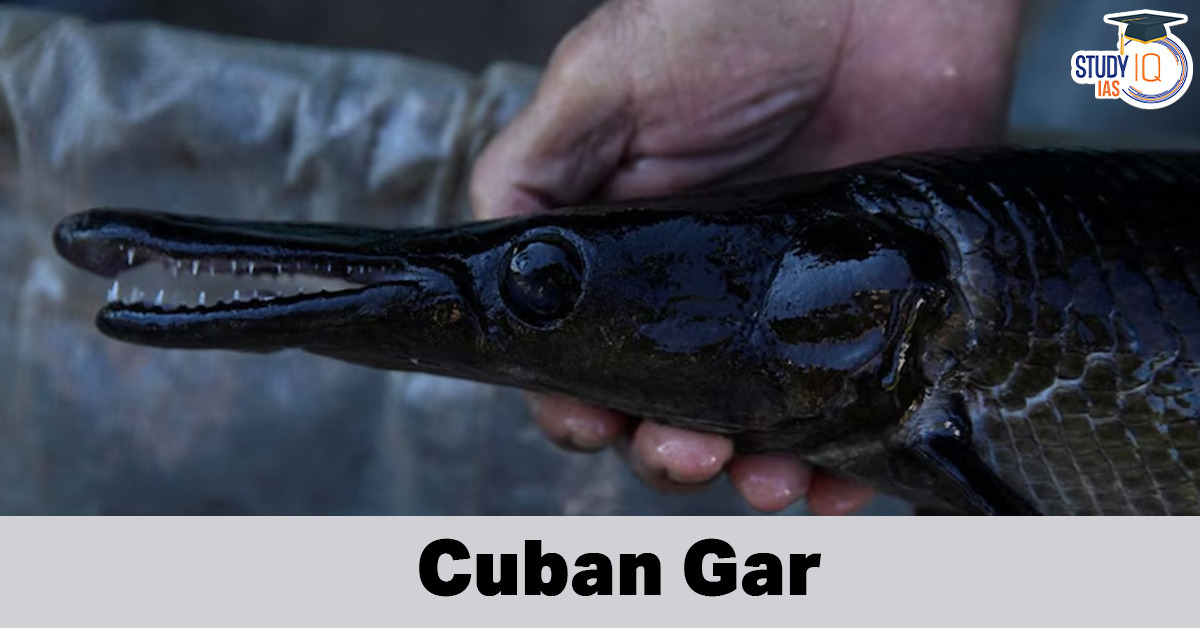Table of Contents
Deep in the misty wetlands of western Cuba lurks a living relic — the Cuban gar (Atractosteus tristoechus), better known locally as the manjuarí. With its armored body, crocodile-like snout, and teeth sharp enough to shred prey in an instant, this prehistoric fish has survived every mass extinction for the past 240 million years… but it may not survive the 21st century.
Here’s everything you need to know about one of the planet’s most fascinating — and most endangered — freshwater predators.
Quick Facts About the Cuban Gar
| Feature | Details |
|---|---|
| Common Name | Cuban gar, manjuarí |
| Scientific Name | Atractosteus tristoechus |
| Maximum Size | Up to 2 metres (6.6 ft), usually ~1 metre |
| Appearance | Long, cylindrical body with diamond-hard ganoid scales, olive-green with dark spots |
| Lifespan | 20–30+ years |
| Conservation Status | Critically Endangered |
| Range | Only western Cuba and Isla de la Juventud |
| Habitat | Swamps, slow rivers, floodplains, brackish lagoons |
| Special Ability | Can breathe air using a modified swim bladder — perfect for low-oxygen swamp water |
A True Living Fossil
The Cuban gar belongs to a family of fishes that swam alongside dinosaurs. While T-rex and its contemporaries vanished 66 million years ago, the gar lineage quietly endured. Its heavy armor, ability to gulp air at the surface, and explosive ambush hunting style made it nearly indestructible — until modern threats arrived.
Where It Lives: Cuba’s Pristine (and Fragile) Wetlands
The manjuarí is found only in the slow-moving, vegetation-choked waters of:
- Ciénaga de Zapata (the Caribbean’s largest and best-preserved wetland)
- Lanier Swamp on Isla de la Juventud
- Remote rivers and lagoons in Pinar del Río and Matanzas provinces
These warm, murky habitats are perfect for a stealth predator that lies motionless among roots and then strikes like lightning.
The Biggest Threat: An African Invader
In the late 1990s, the African walking catfish (Clarias gariepinus) was introduced to Cuban fish farms. It escaped, exploded in numbers, and began devouring everything in its path — including baby Cuban gars. This air-breathing invader tolerates drought, poor water quality, and even walks across land to colonize new ponds. Native gars never stood a chance.
Result? The Cuban gar population has crashed. Some experts fear it could disappear from mainland Cuba within a decade without drastic action.
Conservation Efforts Gaining Momentum in 2025
Hope is not lost. Recent initiatives include:
- Captive breeding and release of hatchlings into protected mangrove zones
- Mangrove restoration to create safe nurseries for juveniles
- Strict bans on further exotic catfish introductions
- Eco-tourism programs that fund wetland protection
Every pencil-sized baby gar released into the Zapata Swamp today is a small victory against extinction.
Why the Cuban Gar Matters
It’s more than just a scary-looking fish. The manjuarí is:
- A top predator that keeps entire ecosystems balanced
- A symbol of Cuba’s unique natural heritage (it even appeared on old Cuban peso notes)
- A warning about how quickly invasive species can destroy native biodiversity


 AI and Personality Rights in 2025
AI and Personality Rights in 2025
 Commonwealth Games Host Cities (1930–2...
Commonwealth Games Host Cities (1930–2...
 G20 Summit 2025 Johannesburg: Full Outco...
G20 Summit 2025 Johannesburg: Full Outco...

























